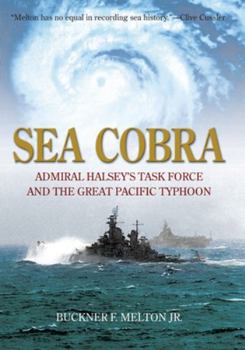Sea Cobra: Admiral Halsey's Task Force and the Great Pacific Typhoon
Select Format
Select Condition 
Book Overview
One of the costliest battles of World War II happens to be one of the least known. After failing to stop the attack of Admiral Takeo Kurita at Leyte Gulf, Admiral "Bull" Halsey made a desperate attempt to engage the Japanese Imperial Navy in a full-scale battle. Acting against better judgment and in a desperate attempt at redemption, Halsey led his crew into the raging path of a typhoon, which resulted in the loss of nearly one thousand sailors--the...
Format:Hardcover
Language:English
ISBN:1592289789
ISBN13:9781592289783
Release Date:March 2007
Publisher:Lyons Press
Length:344 Pages
Weight:1.50 lbs.
Dimensions:1.1" x 6.2" x 9.2"
Customer Reviews
5 ratings
great read
Published by Thriftbooks.com User , 14 years ago
I'm not much of a literary reviewer, but this is a great book. If you like ships, the sea and WW2 history this is for you. I have seen Admiral Halsey's cabin on the Battleship New Jersey. It's a moving experience. Read this book!! You won't be sorry
Sea Cobra
Published by Thriftbooks.com User , 16 years ago
Fantastic. Extremely well written. I lost a family member to Typhoon Cobra USS Spence DD 512. Absolutely the best historical read of this tragic event!
Men and an Angry Sea, Part I
Published by Thriftbooks.com User , 16 years ago
In 2007 two different publishers released two different books on the 1944-1945 typhoons that sank three ships in the U.S. Third Fleet. Under the command of Admiral William Halsey, the U.S. Navy lost more men due to these natural disasters than it did at the battle of Midway. Bob Drury and Tom Clavin's "Halsey's Typhoon" was the first one to make it to book stores and garnered more attention and sales than Buckner F. Melton Jr.'s "Sea Cobra." Given the timing and focus of these two books, this review will compare and contrast the two. In short, there is no question that Melton wrote the better book. The illustrations of carriers, battleships, oilers, destroyers, and destroyer escorts compared to 30, 60, and 90 foot waves is the best feature of Drury and Clavin's account. It gives landlubbers a good idea of how rough seas are problems for some ships and not for others. The shortcomings of this book, however, are much more significant. First, the book ignores altogether the second typhoon Halsey sailed into. Melton discusses this one, but not at length. This brevity is understandable, the second typhoon did less damage and sank no ships. It does show, though, that the commander and staff of the Third Fleet learned little from their experiences with the first typhoon despite efforts to do so. The problem that Drury and Clavin have is that this second storm undermines their argument that Halsey was largely blameless for sailing into the typhoons. The mechanics of publishing also favor Melton. Drury and Clavin have only one map. Melton has nine. He also provides an extensive bibliography and footnotes, whereas Drury and Clavin have a brief bibliography and make no effort to provide any sort of documentation on their sources. Drury and Clavin also make a number of basic mistakes when it comes to nautical matters and use maritime terms incorrectly. Examples include "helming" a ship; calling a battle jack a "battle guideon" (an Army term); referring to a ship's mess deck as its "mess hall." They also put generals in the Japanese Navy Ministry and refer to the Army Ministry as the "War Department" (an American term). Stylistically, Melton is the better wordsmith. Drury and Clavin use too many editorializing adverbs ("legendary" or "untold") to exaggerate the significance of their story. Much more significant is the thesis of each book. Drury and Clavin make Lt. Cmdr. James Marks, captain of the USS HULL, out to be the main villain in this incident. The HULL was one of his ships lost in the first typhoon. This charge seems reasonable at first, but Marks' seamanship does not explain why the USS MONAGHAN and SPENCE sank, nor does it explain a number of close calls on other ships. It seems that the two authors allowed crewmen from the HULL that they interviewed for the book to use the opportunity to settle old scores with Marks. In fact, Drury and Clavin do not spend much time talking about ships other than the HULL while M
tombo01
Published by Thriftbooks.com User , 16 years ago
A great story and a great story-teller! The most user friendly book I've read. There was no over blown technical term or military acronym that I couldn't understand. You didn't have to have 20 years service time in the Navy to know what was happining to the sailors and what the command leadership was doing right or wrong. You felt you right there with the sailors in their battle to survive! An amazing story of heroes and tragedy. The story of Commander Henry Lee Plage of the destroyer USS Tabber is awesome! He stands 3 times taller than John Wayne ever did! He was a 29 year old reservist with only one and a half years of sea time. He amazingly avoided direct orders and rescued over 50 sailors inside the fury of a killer typhoon (almost a thousand sailors died and many ships were sunk or nearly sunk). The other current book on this event "Halsey's Typhoon" doesn't even come close to the passion or power of "Sea Cobra".
stirring and insightful
Published by Thriftbooks.com User , 16 years ago
My father served on an aircraft carrier that survived the typhoon Cobra, and I found this book to be a thorough and compelling account of one of the most disastrous events of WW2.




